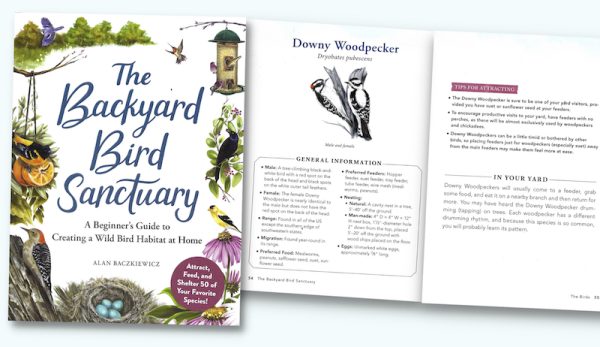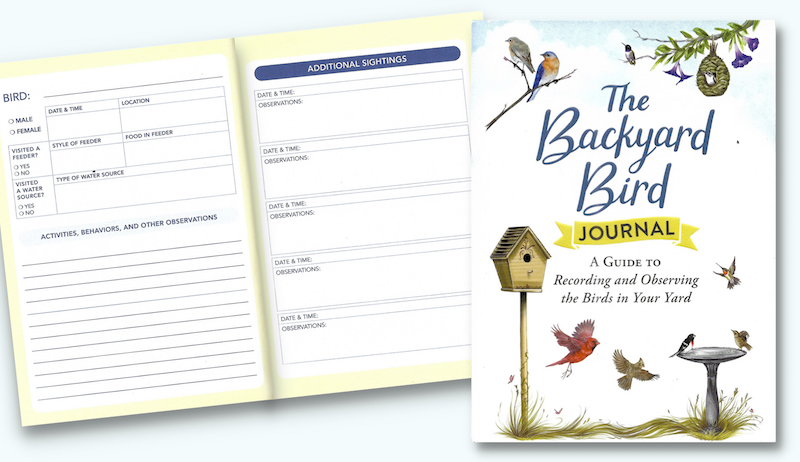
Buffalo, New York-based author Alan Baczkiewicz became an avid birder as a teenager, when his parents took steps to attract bird populations to the backyard. “I was in high school when I first started,” he recalls. “My parents put up bird feeders. We had a suburban yard of just trees and grass.”
These days, Baczkiewicz has 40-plus years’ worth of birding experience under his belt, along with his own birding blog, BasicsOfBirding.com. He shares some of his avian expertise in his new book, The Backyard Bird Sanctuary: A Beginner’s Guide to Creating a Wild Bird Habitat at Home. “It’s the book that I would’ve wanted to read when I first started,” he says. “It’s like knowing what you know now after all these years.”
Eggcetera
The Backyard Bird Sanctuary showcases 50 bird species commonly found in backyards across the U.S. For each one, Baczkiewicz profiles preferred foods and feeder types, migration habits and natural ranges, bird nesting habits and even descriptions of each bird’s eggs.
Baczkiewicz knew he had to add this last part. After all, neighbors on his street—with bits of eggshell in hand—routinely visit him to ask, “What bird was this from?”
“I thought that would be a nice addition, because people are always finding eggshells in their yards in springtime,” he says. “And sometimes eggs are indicative of what [species] they’re from.”
Read more: Invite wild birds with a hand-built nest box!
Blank Slates
The book is particularly well-suited for beginning birdwatchers. “It’s for somebody who doesn’t have any bird feeders in their yard,” he says. “It’s just down from the basics. You’re starting with a fresh yard. You’ve got grass. What do you do to make it enticing for the birds to come in?”
And not just any birds. Baczkiewicz offers enough detail for readers to formulate feeding strategies to attract specific types of birds. For instance, in his own yard, he separates several different food sources.
This helps to attract certain birds and disperse the concentration of at least two nuisance species—starlings and house sparrows.
Care & Feeding
“I have one feeding system at my house,” Baczkiewicz explains. “It’s just one pole with a squirrel baffle at the bottom. And we have shepherd’s hook extensions with [six individual feeders for] sunflower, thistle, safflower, suet and peanuts [in the shell.] There’s one other one with peanuts in a mesh container. That’s for the woodpeckers—so the blue jays don’t take them all.”
He continues, “Every food source is separated by a few feet with the shepherd’s hooks going in opposite directions. You’ll get starlings on the suet feeder. The goldfinches and the house finches will be on the safflower and the thistle. And, because the starlings don’t want the thistle or the safflower, they don’t go on there.
“The woodpeckers and the chickadees will go to the mesh feeder with the peanuts in it. I have a little tray feeder that holds the peanuts for the blue jays, so they go to that. And, for the most part, they keep it civil.”
Even dropped seeds will attract specific birds, including doves, grackles, red-winged blackbirds and the occasional junco.
Read more: Learn how to make a birdhouse with homegrown gourds.
Start Small
Of course, that doesn’t mean you have to go broke buying multiple types of seed. “If you have black oil sunflower seeds at one feeder, you’re going to have birds there no matter what,” Baczkiewicz says. “You’re going to get finches, chickadees, woodpeckers—you’re going to pull in a lot just with black oil sunflower.”
Just don’t expect to see visiting birds right away. “Usually, you’re looking at about four or five days before anybody comes to it,” he adds. “They have to find it.”
Water & Shelter
Providing a water source also helps. “That can attract some spring migrants,” he says. “You might get some warblers that maybe don’t want to eat there but are looking for a water source.”
As a teen, Baczkiewicz simply turned a garbage can lid into a bird bath. “That was just something nice and easy, because, back then, I didn’t have money to spend on anything,” he remembers.
Natural plantings of trees and shrubs will also give birds a leg up. These can be important food sources in and of themselves. However, when positioned near—but not too near—bird feeders, such plantings provide birds with much-needed protection, too.

Take Note
Once you’ve started attracting new birds to your yard, you might want to keep tabs on them for posterity. To that end, check out The Backyard Bird Journal: A Guide to Recording and Observing the Birds in Your Yard. The companion book includes spots for recording the different species you see, their feeding habits, activities, behaviors and more.




